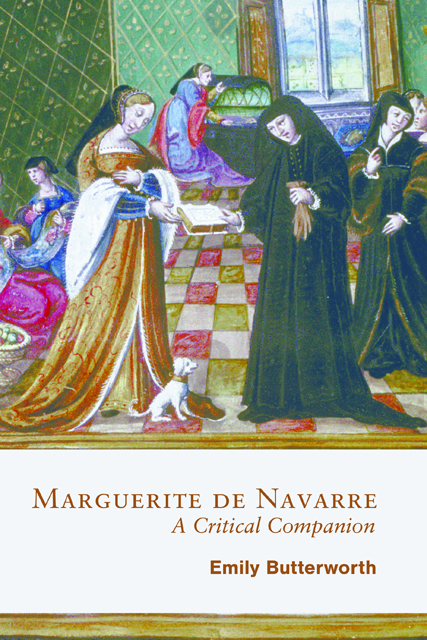Book contents
- Frontmatter
- Dedication
- Contents
- List of Illustrations
- Acknowledgements
- Note on Names and Editions
- Editions of Reference
- Introduction: A Brief Literary and Historical Chronology
- 1 Communities
- 2 Religion
- 3 Politics
- 4 Women and Men
- 5 Desire
- 6 Form and Technique
- Conclusion: Print and Public
- Bibliography
- Index
6 - Form and Technique
Published online by Cambridge University Press: 20 December 2023
- Frontmatter
- Dedication
- Contents
- List of Illustrations
- Acknowledgements
- Note on Names and Editions
- Editions of Reference
- Introduction: A Brief Literary and Historical Chronology
- 1 Communities
- 2 Religion
- 3 Politics
- 4 Women and Men
- 5 Desire
- 6 Form and Technique
- Conclusion: Print and Public
- Bibliography
- Index
Summary
This final chapter is about the forms and techniques in Marguerite’s work. Over her long writing career, Marguerite experimented with many different forms: allegorical poetry, verse letters, theatre, song, and narrative fiction. Rather than consider these individually, I focus here on her best-known text, the Heptameron, referencing other works to explore how she drew on various literary traditions and techniques. First, I look at the dialogue form, which she employs from the early poem Dialogue en forme de vision nocturne to the later Navire, and as a structuring technique in Heptameron. Next, I consider the use of narrative voice to see how it produces an interrogative, collaborative, open-ended effect. The Heptameron refers to the stories it tells with a variety of different terms, and I consider two of the most prominent, nouvelle and histoire, to explore what it shares with these contemporary narrative genres. Both nouvelle and histoire make claims of exemplarity, and in a final section, I consider how the stories in the Heptameron both demonstrate and problematise the power of the exemplary model.
Dialogue and Conversation
The dialogue form is important throughout Marguerite’s works. Some texts are written in dialogue form, like the Dialogue en forme de vision nocturne (which was one of the first texts in French to use the title dialogue) and La Navire – both dialogues with the dead in which voices alternate, answer questions, and advise. But other works also make extensive use of dialogic techniques. Marguerite’s plays exploit the intrinsic dialogism of the theatre, sometimes to stage spiritual enlightenment (as in L’Inquisiteur), sometimes to highlight spiritual deafness (as in Trou Prou Peu Moins). The chansons spirituelles echo dialogue’s pedagogical technique of gradual realisation; they often imply an interlocutor who listens and learns. The Heptameron is structured on dialogic principles, with the discussions after the stories taking on as much importance – and taking up nearly as much space – as the stories themselves. In these discussions, points of view are defended, challenged, and revised, in an open-ended movement towards meaning and interpretation. This model of dialogue, in which different, mutually incompatible, and sometimes antagonistic opinions are accommodated and allowed to coexist, albeit sometimes uneasily, seems particularly significant when put into the context of the contemporary failed attempts at dialogue between Catholicism and Protestantism.
- Type
- Chapter
- Information
- Marguerite de NavarreA Critical Companion, pp. 163 - 190Publisher: Boydell & BrewerPrint publication year: 2022

